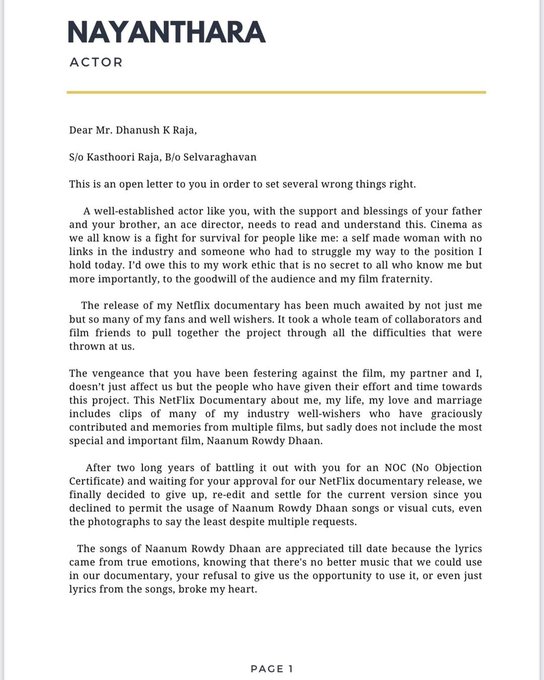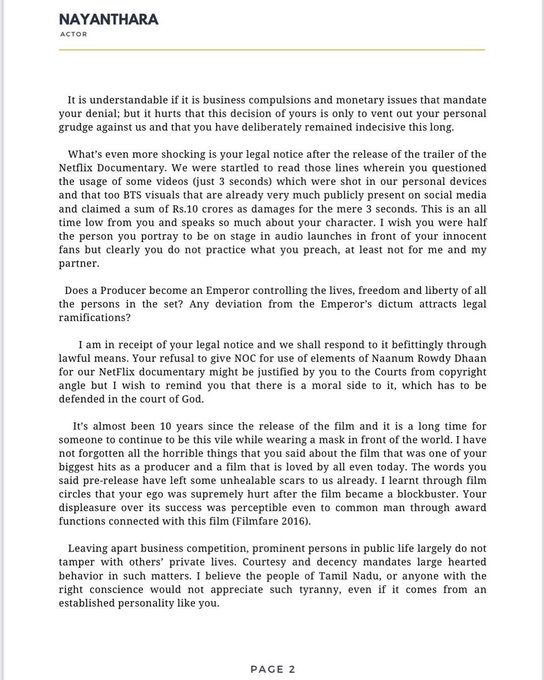
In the world of cinema, where every second counts, a mere three-second clip has become the center of a legal and public dispute between Nayanthara and Dhanush. This incident isn’t just about who owns what; it’s a lesson in copyright, personal rights, and the dynamics of modern media. Nayanthara vs Dhanush: A Three-Second Clip Sparks Controversy
The Spark of the Conflict
The issue began when Nayanthara’s documentary, “Nayanthara: Beyond The Fairy Tale,” featured a snippet from “Naanum Rowdy Dhaan,” produced by Dhanush. This clip, although short, triggered a legal notice from Dhanush, demanding Rs 10 crore for its unauthorized use. This isn’t merely a dispute over copyright but a reflection on how personal moments can be commercialized in the digital age.
Copyright in the Digital Era
- Legal Framework: Under Indian Copyright Law, the producer typically holds the rights to film footage. However, when it comes to behind-the-scenes content, especially if captured on personal devices, the waters get murky. The case of T-Series vs. Super Cassettes highlighted that even promotional content could be copyrighted, but personal content might fall outside this scope.
- Fair Use Debate: There’s an ongoing discussion about what constitutes ‘fair use’ in documentaries. Courts have sometimes sided with fair use when content is used for criticism, commentary, news reporting, teaching, or research, as seen in cases like Sony Corp. of America v. Universal City Studios, Inc.
The Public and Legal Response
- Nayanthara’s Stand: She responded with an open letter, addressing not just the legal notice but the morality of the claim. Her argument touches on the essence of documentary filmmaking, which often relies on personal anecdotes and moments not typically covered by traditional copyright.
- Public Sentiment: Social media platforms, particularly X (formerly Twitter), have shown a divide. Some see Dhanush’s claim as an overreach, while others view it as a necessary protection of intellectual property. The discourse has led to calls for clearer guidelines on copyright in digital content.
Analyzing the Ripple Effects
- Industry Impact: This case might prompt filmmakers to be more diligent about securing permissions for even the smallest snippets. It also raises questions about how documentaries can navigate the fine line between personal storytelling and copyright infringement.
- Precedent Setting: If resolved with a court ruling, this could set a precedent for how personal content is treated in legal contexts, potentially affecting how actors, directors, and producers handle content ownership in future projects.
What This Means for Content Creators
- Permission Over Paranoia: Always seek explicit permissions for using any content, even if it seems trivial or widely shared.
- Documentary Filmmaking: Documentarians might need to rethink their approach, possibly opting for more original content or ensuring all clips used are legally cleared.
- Ethical Considerations: Beyond legalities, there’s an ethical dimension. Content creators should consider the implications of using personal content, especially when it involves other individuals’ rights and privacy.
The Nayanthara-Dhanush legal clip drama underscores the complexities of copyright in today’s digital landscape. It’s a reminder of the need for clear agreements, the potential for legal battles over what might seem insignificant, and the ever-evolving narrative of who owns what in the art of storytelling.
For those in the industry or anyone interested in copyright law, this saga serves as both a cautionary tale and a call to action to engage more deeply with the legal frameworks that govern our creative expressions.
Key Takeaways
- Secure permissions for all content, no matter how small.
- Understand the nuances of copyright, especially in personal or documentary filmmaking.
- Stay updated with legal precedents and changes in copyright law to navigate future disputes.
In the grand scheme, while this spat might be over a fleeting moment on screen, its implications could echo through the halls of legal and creative discourse for years to come.


